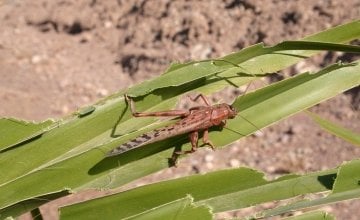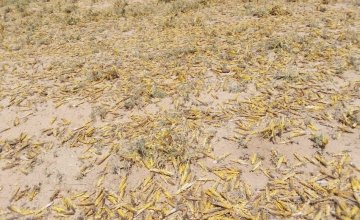
Knowledge Hub
Seven alarming facts about desert locusts

The current infestation of desert locusts across East Africa marks the worst in decades. Huge swarms are devastating crops in Somalia, Ethiopia and Kenya, putting the lives and livelihoods of millions at risk.
But how can an insect no larger than a piece of penne pasta cause such colossal damage? Look no further – we’ve got the lowdown on desert locusts.
1. Desert locusts can transform from lone creatures to sociable ones
The scientific name for a desert locust is ‘schistocerca gregaria’, describing their ability to change from a solitary creature to one with a sociable, “gregarious” nature. This transformation is caused by warm, wet weather, in which desert locusts congregate into massive swarms. They begin to breed rapidly, depositing their eggs in the soil which hatch quickly in these favourable conditions.
2. Once they’ve swarmed, locusts physically transform
Their usual brown colour - which acts as camouflage in the desert - changes to a vibrant yellow and their muscles grow, enabling them to travel long distances and ravage vast acres of land. In swarms, they find safety in numbers and are no longer mindful of the need to hide from predators.

3. One adult can eat its own weight in food every day
After they’ve formed swarms, desert locusts develop an insatiable appetite. The average mass of a locust is two grams – and they can eat up to that amount in fresh vegetation each day. A swarm covering one square kilometre can eat as much food in a day as 35,000 humans.
4. Locusts are migratory pests – and can travel up to 90 miles a day
Once all the crops in their path have gone, locusts begin to migrate to find more food. Swarms of desert locusts are constantly in motion and can cover huge distances. In 1954, a swarm flew from northwest Africa to Great Britain. In 1988, another made the extensive journey from West Africa to the Caribbean.
5. Plagues of desert locusts could threaten the livelihoods of one in 10 people around the world
Once a swarm lands, locusts will eat crops relentlessly until there’s nothing left. This could have devastating consequences for the millions of people across the affected region who depend on farming to earn a living.

6. The number of locusts could multiply by 500 times by June 2020
In these sustained weather conditions, new generations of locusts can breed within three months – and each generation brings with it a 20-fold increase of locusts. This could be catastrophic for people and economies across East Africa, causing food supplies to run critically low. Without crops, cows and goats will simply collapse from starvation and waste away. The UN has said that more than 20 million people living in Kenya, Somalia and Ethiopia could be affected.
7. Climate change could see us experience many more locust swarms
In May and October 2018, two devastating cyclones hit East Africa. The heavy rainfall that followed provided the moist conditions desert locusts require to breed. Warmer seas caused by climate change could lead to more cyclones, which in turn could lead to an increase in species of locusts such as this – and an increase in frenzied, cross-continental swarms searching for food. Without interventions, these swarms could last for years until the pests naturally die off.
The potential for destruction from the locust swarms is enormous – endangering people’s lives both now and long into the future. That’s why we’ve launched our East Africa Locust Emergency Appeal, which is supporting affected families with the food, seeds and agricultural tools they need to survive and rebuild their lives.
This crisis isn’t going anywhere – and we need your help, now.





